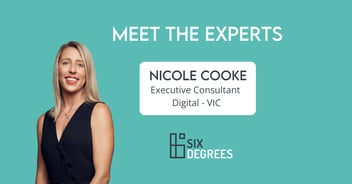
Why technology can't replace human connection in Executive Research

As the Research Manager at Six Degrees Executive, my role in Executive Search has evolved from a supportive capacity to a critical driver of strategic talent solutions, specifically tailored for C-suite placements.
This transformation has allowed me to shape and influence high-impact hiring decisions at the highest levels of leadership, helping clients secure talent that aligns with their strategic objectives and organisational culture.
Today, researchers are not only relied upon for candidate identification but also as strategic partners who mirror market conditions and act as the first point of contact for the talent we approach. This evolving role allows us to provide insights that directly impact the quality and success of executive placements.
With the recruitment landscape continuously changing and clients seeking specific skill sets and experiences, it is critical that we leverage the latest technology platforms, understand industry nuances, and drive diversity initiatives, making researchers an indispensable resource in today’s executive search landscape. These shifts underscore how the research function is reshaping executive search and creating added value for our clients.
In my opinion, there are several key trends highlighting the importance of a dedicated researcher in Executive Search:
1. Data-driven insights: In essence, today’s researchers go beyond candidate identification; we harness data-driven insights to guide clients on market dynamics and talent strategies that fuel business growth and drive competitive advantage. For example, by leveraging tools like LinkedIn Talent Insights, we map industry shifts and identify high-demand skill sets, empowering clients to anticipate talent trends and maintain a competitive edge in their field.
2. Enhanced candidate sourcing : Leveraging advanced sourcing techniques such as social media mining and competitor analysis allows researchers to uncover high-value, passive candidates who may not be visible on traditional job boards. This approach enhances the quality of placements and helps build long-term, trusted client relationships by providing talent that aligns with specific strategic needs.
3. Focus on diversity and inclusion: In my experience prioritising diverse talent pools has a powerful impact on search results and business outcomes for our clients. By strategically sourcing diverse candidates we’ve enabled clients to increase gender diversity within executive teams, fostering more inclusive leadership dynamics that drive innovation and improved decision-making.
A McKinsey study on inclusive leadership shows that companies with diverse leadership outperform their peers by up to 35%—a testament to the value of diversity in achieving sustainable growth and resilience.
This has certainly been the case in Board recruitment, where the demand for First Nations background or specific lived experience is not about tokenism but critical if an organisation to be seen as authentic and relevant to its cause and mission.
4. Increased collaboration with consultants: Collaboration between researchers and consultants is essential for tailoring searches to align precisely with client needs. This synergy ensures comprehensive market insight, enabling more targeted searches and quicker placements. Regular communication and feedback loops enhance alignment, leading to high-quality, strategic matches that support client goals and strengthen overall search outcomes.
5. Candidate experience: In Executive search the candidate should always become the future client so best practice candidate experience is vital. This is not just the placed candidates, but every individual involved in the process.
How is this achieved? It comes down to the simple principles of regular, proactive and transparent updates and saying you will call when you say so. With all the best intentions, this can be challenging with busy schedules. Use of CRM tools to track candidate touchpoints is useful in achieving this, ensuring every candidate feels valued throughout the process.
6. Technology Integration: While researchers leverage advanced tech tools like AI-powered search engines and predictive analytics to streamline the identification of top talent, it is their ability to interpret these data points and apply human judgment that makes the process truly effective. This combination accelerates the search while ensuring that candidates align with the nuanced needs of the client's culture and leadership expectations.
7. Market intelligence as a strategic edge: Dedicated researchers provide more than just candidate identification; they deliver critical market intelligence that helps clients understand talent availability, salary benchmarks, and competitor movements. This insight supports clients in making informed decisions and positioning their organisations attractively to top candidates.
Conclusion
While technology has transformed data analysis and initial sourcing, it cannot replicate the nuanced human judgment essential in executive research - particularly when assessing cultural fit and leadership qualities.
Researchers bring a unique combination of analytical skills and intuition, enabling us to distinguish the right talent and align candidates with a client’s unique culture and values.
If your organisation seeks a strategic partner to leverage cutting-edge research techniques and expand access to exceptional leadership talent, connect with Alisa Imfeld and our Executive Search team for a personalised consultation.
Related


Meet the Experts: Nicole’s insights on the evolution of digital marketing
Welcome to our Meet the Experts series, where we spotlight the industry specialists at Six Degrees...

7 ways to revamp your EVP in 2025 to attract and retain talent
Gone are the days when office perks like foosball tables and free lunches were enough to attract...


 Accessibility
Accessibility